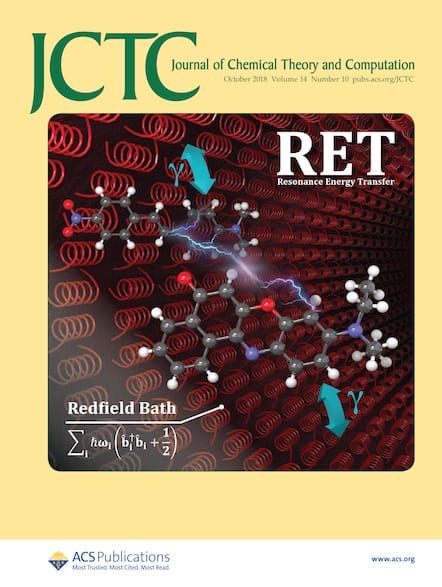Reproducibility of QM/MM Calculations for the SARS-CoV-2 Main Protease.
IF 5.7
1区 化学
Q2 CHEMISTRY, PHYSICAL
引用次数: 0
Abstract
Combined quantum mechanics and molecular mechanics (QM/MM) calculations are a popular approach to study reaction mechanisms of enzymes. However, recently, the reproducibility of such calculations has been questioned, comparing the results of two software: NWChem and Q-Chem. Here, we continue and extend this study by including three additional software─ComQum, ORCA, and AMBER─using the same test case, the covalent attachment of the carmofur inhibitor to the catalytic Cys-145 residue of the SARS-CoV-2 main protease, using a quantum region of 83 atoms. We confirm that the various software programs give varying results for the reaction (ΔE) and activation (ΔE‡) energies. The main reason for the variation is how charges around the cleaved bonds between the QM and MM regions are treated, i.e., the charge-redistribution scheme. However, there are still differences of ∼10 kJ/mol between different implementations of the same method in ComQum and ORCA. Some of these problems can be solved by calculating the final energies with larger QM systems. We show that energies calculated with the big-QM approach are reasonably converged if atoms within 8 Å of the minimal QM region are included (∼1400 atoms), solvent-exposed charged residues are neutralized, and the calculation is performed in a continuum solvent with a dielectric constant of 80. On the other hand, we show that different setups of the protein lead to even larger differences in the calculated energies, by up to 114 kJ/mol. Even if the same approach is used and the only difference is how water molecules are added (by random) to the crystal structure, energies differ by 18-57 kJ/mol. The results also strongly depend on how much of the surrounding protein and solvent are relaxed in the calculations. Therefore, it seems that for a solvent-exposed active site, QM/MM calculations with minimized structures cannot be recommended. Instead, methods that incorporate dynamic effects and calculate free energies seem preferable.SARS-CoV-2主蛋白酶QM/MM计算的可重复性
量子力学和分子力学相结合的计算方法是研究酶反应机理的常用方法。然而,最近,通过比较NWChem和Q-Chem两种软件的结果,这种计算的可重复性受到了质疑。在这里,我们继续并扩展了这项研究,包括另外三个软件──ComQum、ORCA和AMBER──使用相同的测试案例,carmofur抑制剂与SARS-CoV-2主要蛋白酶的催化Cys-145残基的共价附着,使用83个原子的量子区域。我们证实,不同的软件程序给出不同的结果,反应(ΔE)和活化(ΔE‡)的能量。这种变化的主要原因是如何处理QM和MM区域之间的劈裂键周围的电荷,即电荷再分配方案。然而,ComQum和ORCA中相同方法的不同实现之间仍然存在~ 10 kJ/mol的差异。其中一些问题可以通过计算更大质量管理系统的最终能量来解决。我们表明,如果包括最小QM区域8 Å内的原子(~ 1400个原子),溶剂暴露的带电残基被中和,并且在介电常数为80的连续介质溶剂中进行计算,则用大QM方法计算的能量是合理收敛的。另一方面,我们发现蛋白质的不同设置导致计算能量的更大差异,高达114 kJ/mol。即使使用相同的方法,唯一的区别是如何将水分子(随机)添加到晶体结构中,能量也会相差18-57千焦/摩尔。结果还很大程度上取决于计算中周围蛋白质和溶剂的松弛程度。因此,对于溶剂暴露的活性位点,不推荐使用最小化结构的QM/MM计算。相反,结合动态效应和计算自由能的方法似乎更可取。
本文章由计算机程序翻译,如有差异,请以英文原文为准。
求助全文
约1分钟内获得全文
求助全文
来源期刊

Journal of Chemical Theory and Computation
化学-物理:原子、分子和化学物理
CiteScore
9.90
自引率
16.40%
发文量
568
审稿时长
1 months
期刊介绍:
The Journal of Chemical Theory and Computation invites new and original contributions with the understanding that, if accepted, they will not be published elsewhere. Papers reporting new theories, methodology, and/or important applications in quantum electronic structure, molecular dynamics, and statistical mechanics are appropriate for submission to this Journal. Specific topics include advances in or applications of ab initio quantum mechanics, density functional theory, design and properties of new materials, surface science, Monte Carlo simulations, solvation models, QM/MM calculations, biomolecular structure prediction, and molecular dynamics in the broadest sense including gas-phase dynamics, ab initio dynamics, biomolecular dynamics, and protein folding. The Journal does not consider papers that are straightforward applications of known methods including DFT and molecular dynamics. The Journal favors submissions that include advances in theory or methodology with applications to compelling problems.
 求助内容:
求助内容: 应助结果提醒方式:
应助结果提醒方式:


